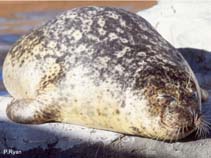Phoca vitulina Linnaeus, 1758
Harbour seal| Native range | All suitable habitat | Point map | Year 2050 |

|
| This map was computer-generated and has not yet been reviewed. |
| Phoca vitulina AquaMaps Data sources: GBIF OBIS |
Classification / Names ชื่อสามัญ | ชื่อพ้อง | CoL | ITIS | WoRMS
Mammalia | Carnivora | Phocidae
Environment: milieu / climate zone / ระดับความลึก / distribution range นิเวศวิทยา
สัตว์หน้าดินในเขตน้ำลึก. Temperate; 90°N - 0°S, 180°W - 180°E
Distribution ประเทศต่างๆ | พื้นที่จำแนกตาม FAO | ระบบนิเวศหลายระบบ | การปรากฏขึ้น,การเกิดขึ้น,พบ | การแนะนำ
Atlantic Ocean, Pacific Ocean, the Arctic and North America Inland Waters: Portugal, Iceland, Greenland, Canada Newfoundland, Spain, France, Belgium, Ireland, Netherlands, Germany, Denmark, Norway, Sweden Lithuania, Poland, Latvia, Estonia, Finland, Russia, UK, USA, Canada, Mexico, Alaska, Japan, Kamchatka (Ref. 1394), Br Scotland, Madeira, British Columbia, Kuril Island, Sea of Okhotsk, Gulf of California, Baltic Sea, Barents Sea, Hudson Bay (Ref. 1522); Phoca vitulina vitulina: Portugal, UK, Iceland, Greenland, Br Scotland, Norway, Madeira, Baltic Sea, Barents Sea; Phoca vitulina concolor: Canada, Hudson Bay, USA, Greenland, Iceland; Phoca vitulina richardii: Mexico, Alaska, British Columbia, USA, Gulf of California; Phoca vitulina stejnegeri: Japan, Kamchatka, Alaska, Sea of Okhotsk, Kuril Island; Phoca vitulina mellonae: Hudson Bay, James Bay. Temperate to polar regions.
Length at first maturity / ขนาด / Weight / Age
วัยเจริญพันธุ์: Lm ? range ? - ? cm Max length : 190 cm TL เพศผู้/กระเทย; (อ้างอิง 1394); 170 cm TL (female); น้ำหนักสูงสุดที่มีการรายงาน: 150.0 kg (อ้างอิง 1394); น้ำหนักสูงสุดที่มีการรายงาน: 150.0 kg
Life cycle and mating behavior วัยเจริญพันธุ์ | การสืบพันธุ์ | การวางไข่ | Eggs | ความดกของไข่ | Larvae
Main reference
อ้างอิง | ผู้ประสานงาน | ผู้ร่วมมือ
Jefferson, T.A., S. Leatherwood and M.A. Webber 1993 FAO species Identification Guide: Marine Mammals of the World. Rome, FAO. 320 p. + 587 figures. (อ้างอิง 1394)
IUCN Red List Status
(อ้างอิง 130435: Version 2025-1)
CITES status (อ้างอิง 108899)
CMS (อ้างอิง 116361)
Threat to humans
Human uses
การประมง: การค้า
FAO - การประมง: landings, species profile | FishSource | ทะเลรอบๆเรา
เครื่องมือ
ข้อมูลเพิ่มเติม
Max. ages / sizes
Length-weight rel.
Length-length rel.
Length-frequencies
Mass conversion
อุดมสมบรูณ์
วัยเจริญพันธุ์
ความดกของไข่
การวางไข่
Eggs
Egg development
Larvae
แหล่งที่มาจากอินเตอร์เน็ต
BHL | BOLD Systems | CISTI | DiscoverLife | FAO(การประมง: species profile; publication : search) | Fishipedia | GenBank (genome, nucleotide) | GloBI | Gomexsi | Google Books | Google Scholar | Google | PubMed | แผนภูมิชีวิตแบบต้นไม้ | Wikipedia (Go, ค้นหา) | บันทึกทางด้านสัตววิทยา



